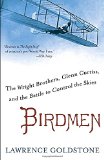Summary | Excerpt | Reviews | Beyond the Book | Readalikes | Genres & Themes | Author Bio
The Wright Brothers, Glenn Curtiss, and the Battle to Control the Skies

Critics' Opinion:
Readers' Opinion:
First Published:
May 2014, 448 pages
Paperback:
Apr 2015, 448 pages
 Book Reviewed by:
Book Reviewed by:
Poornima Apte
Buy This Book
To make the problem even more intractable, air, the medium of flight, is invisible, while for early theoreticians of flight, science was based almost entirely on sensory observation. Unlike modern scientists, they did not have the tools to deal with phenomena they could not see, hear, or touch. For inquiries into the mechanics of DNA replication or the detection of dark matter in the universe, for example, sophisticated instruments and powerful computers are routinely employed to test hypotheses. The ability to test with precision allows theory to precede observation. Einstein's theory of relativity, first advanced in 1905, was not proven until a solar eclipse in 1919 provided the opportunity for astronomers to actually observe through a telescope light bending around a distant star.
Lacking such precision, a scientist can only extrapolate from observations in the natural world. Heavier-than- air flight was possible, of course—one need only watch a bird to appreciate that. So why couldn't man fly as well? Yet as late as 1868, after more than two thousand years of study, the annual report of the Aeronautical Society of Great Britain lamented, "With respect to the abstruse question of mechanical flight, it may be stated that we are still ignorant of the rudimentary principles which should form the basis and rules for construction."
Achieving human flight, then, turned out to be a giant puzzle, solved over centuries, piece by tortuous piece. Since air wasn't even yet understood to be an actual substance, the first steps involved fluids. In 350 b.c., Aristotle hypothesized that an object moving through liquid will encounter resistance, and a century later Archimedes developed the first theory of fluid motion. From there, it would take more than seventeen centuries until Leonardo took up the problem and fluid dynamics began to be thought of as a rigorous discipline.
Leonardo's great contribution was based in his observation that when the banks of a river narrowed to constrict its flow, the water in the narrower area speeded up so that the movement of the river remained "continuous." Leonardo could not quantify this function but his observation was eventually generalized into a mathematical relationship between speed and distance and eventually between speed and pressure—the faster a fluid moves over a surface, the less pressure it produces. But as Leonardo was also fascinated with bird flight, he made some effort to apply the principle to gases. That ultimately would result in a device where air moved farther and faster over the top surface of an airfoil than under the bottom, thus creating uneven pressure, which resulted in "lift." He also understood that as an object moved through a medium, it would encounter resistance, friction between the object and the medium, which would slow its progress, later to be quantified as "drag."
It took another century for the next tentative step forward, this in 1600 by Galileo. The great Pisan astronomer was the first to quantify certain relationships in fluid dynamics and thus began to create a mechanical science from what had previously been only speculation. His most significant insight was that resistance will increase with the density of the medium, which would eventually lead to the understanding that as an airplane cruised at higher altitudes, fuel efficiencies would increase.
But with all the advances by science's titans, which later would include Isaac Newton and Leonhard Euler, the applications continued to be solely in fluid dynamics—the resulting equations were then simply assumed to apply equally to gas as to liquid. In fact, using his equations, Newton hypothesized that powered flight was impossible because the weight of a motor needed to generate sufficient power would always exceed the amount of lift that could be supplied by airfoils that did not weigh more than the motor could support. For those who believed flight was possible, the assumption remained that humans must emulate birds—that is, develop a mechanism to allow for wings that flapped. Devices that attempted to mimic bird flight in this manner were dubbed "ornithopters." A sketch of such an apparatus was found in one of Leonardo's notebooks.
Excerpted from Birdmen by Lawrence Goldstone. Copyright © 2014 by Lawrence Goldstone. Excerpted by permission of Ballantine Books. All rights reserved. No part of this excerpt may be reproduced or reprinted without permission in writing from the publisher.





The Flower Sisters
by Michelle Collins Anderson
From the new Fannie Flagg of the Ozarks, a richly-woven story of family, forgiveness, and reinvention.

The House on Biscayne Bay
by Chanel Cleeton
As death stalks a gothic mansion in Miami, the lives of two women intertwine as the past and present collide.

The Funeral Cryer by Wenyan Lu
Debut novelist Wenyan Lu brings us this witty yet profound story about one woman's midlife reawakening in contemporary rural China.
Your guide toexceptional books
BookBrowse seeks out and recommends the best in contemporary fiction and nonfiction—books that not only engage and entertain but also deepen our understanding of ourselves and the world around us.